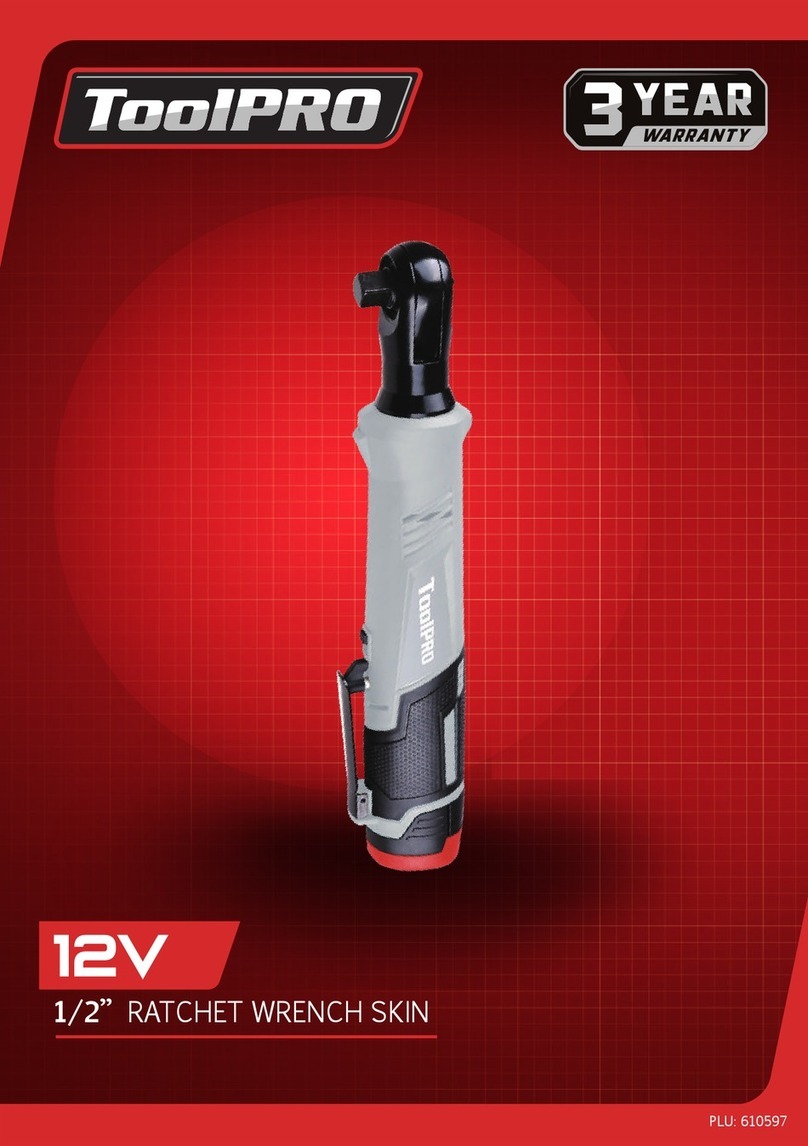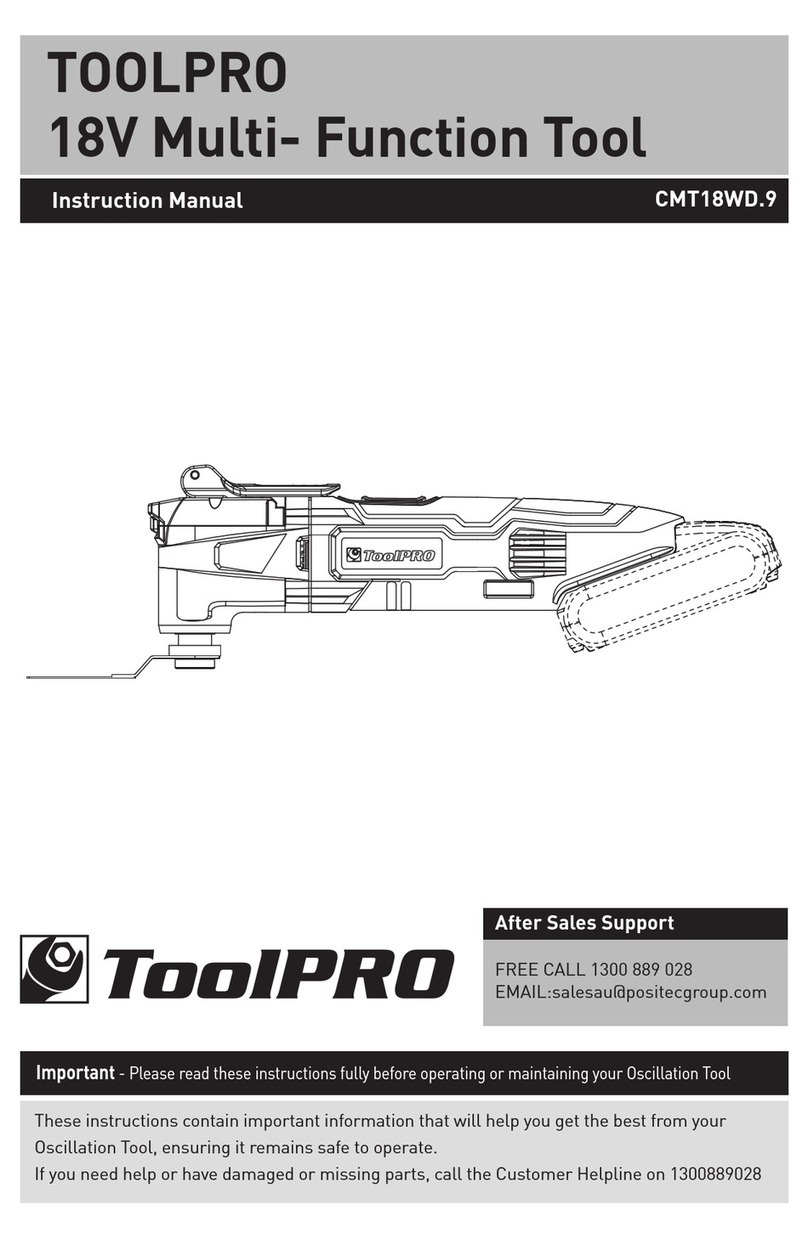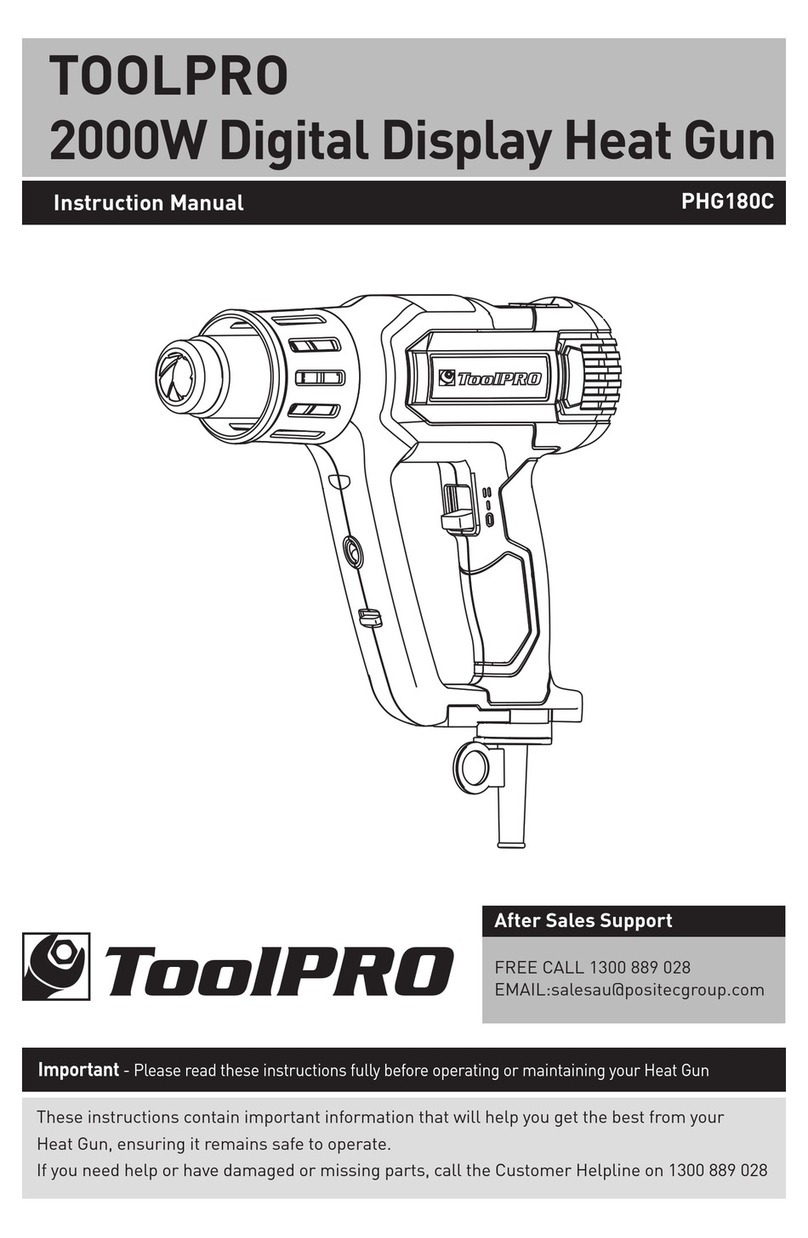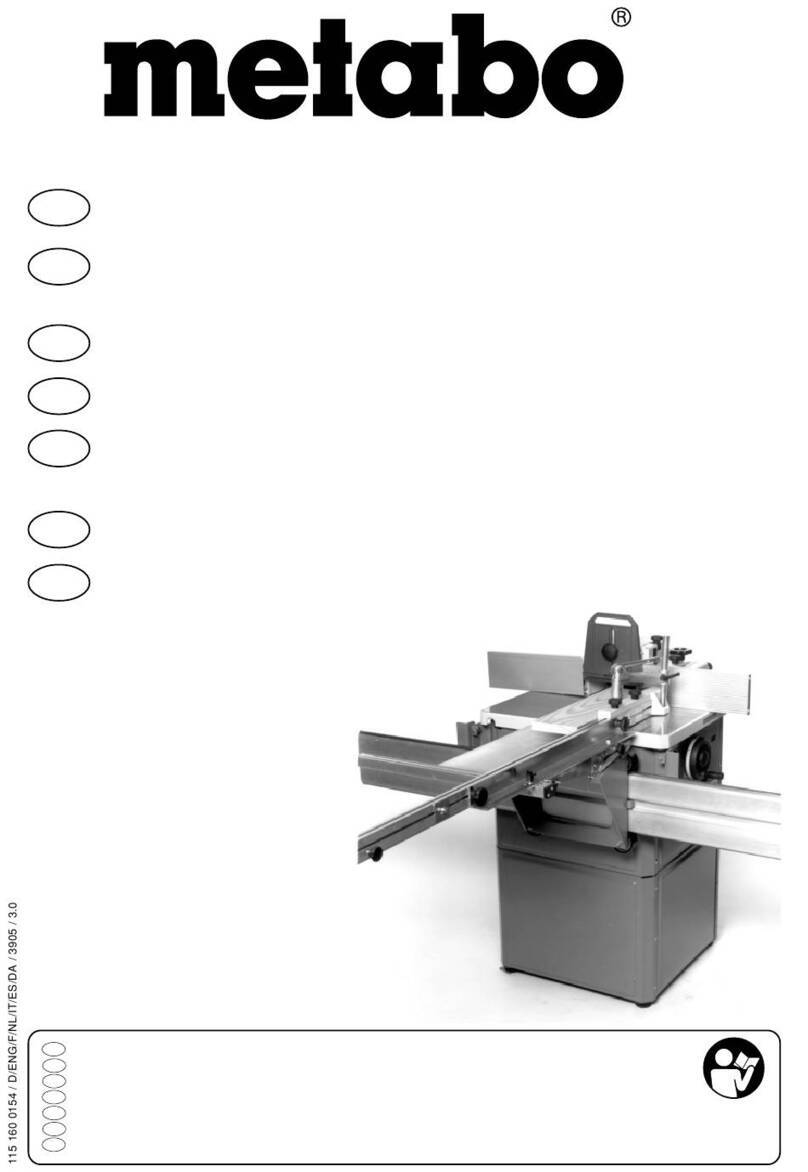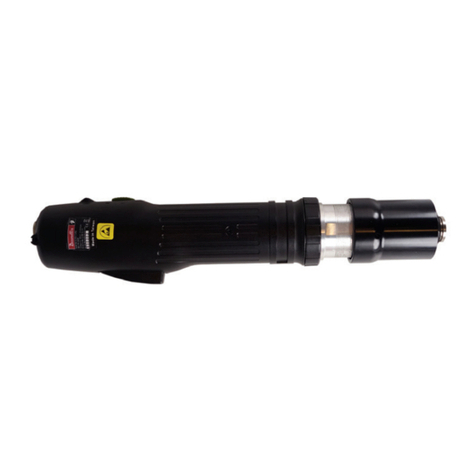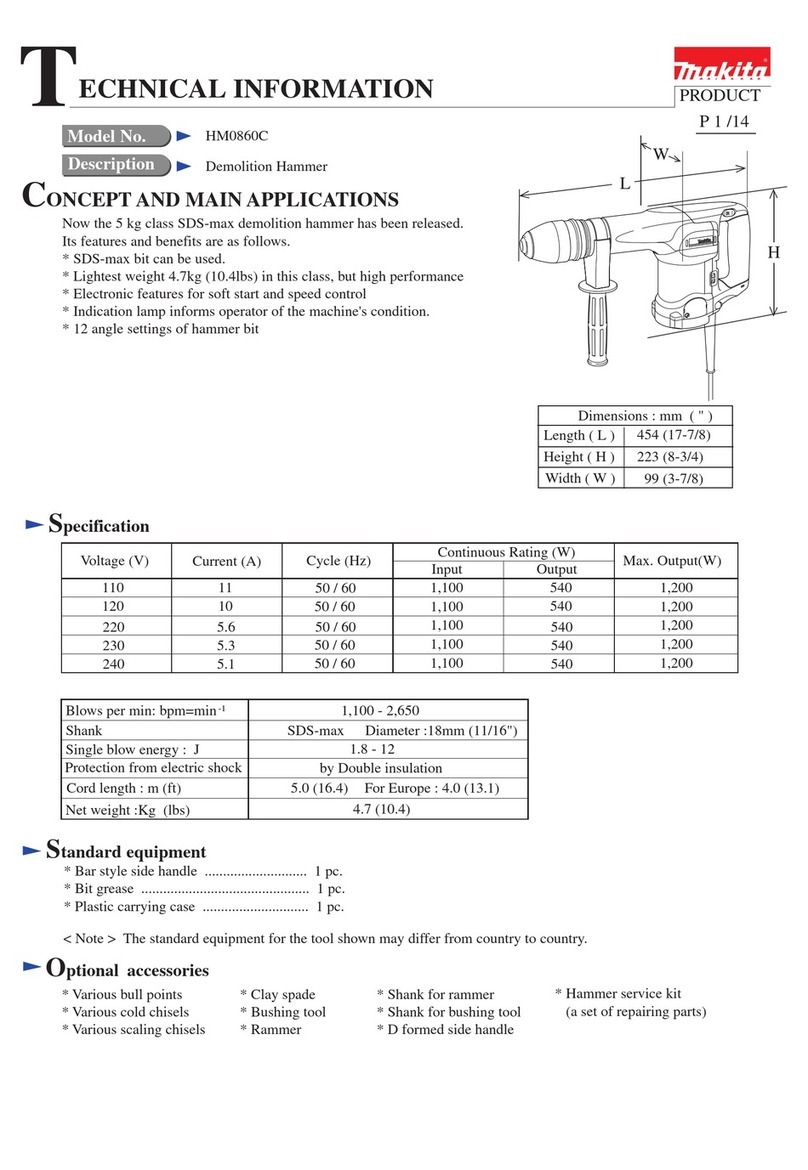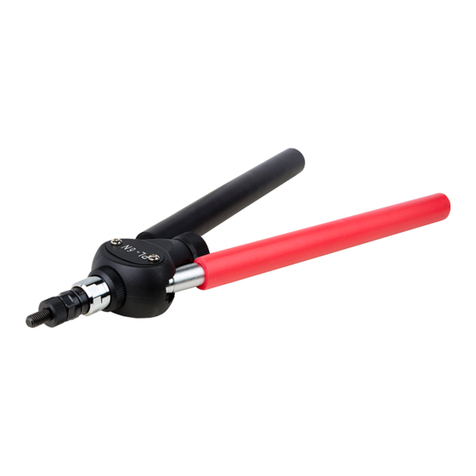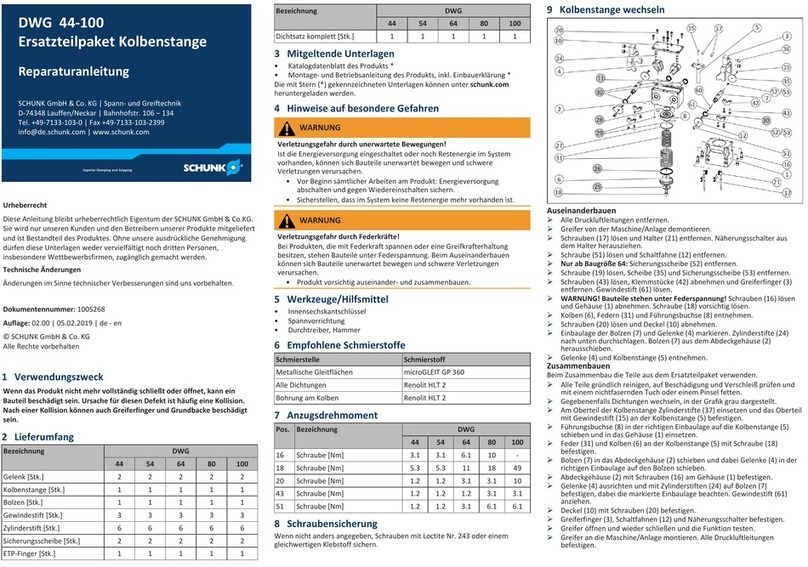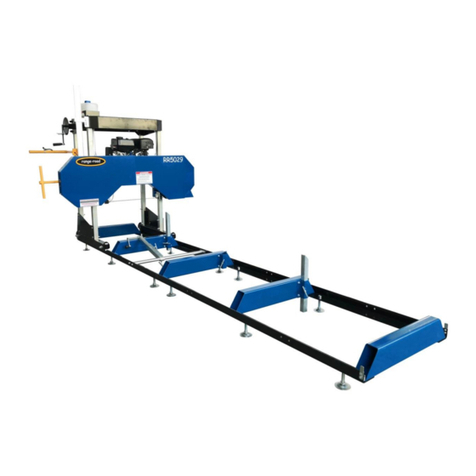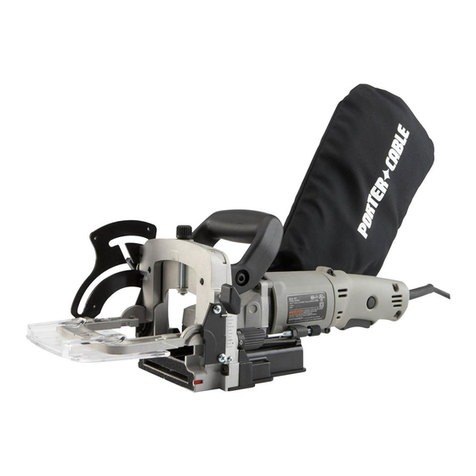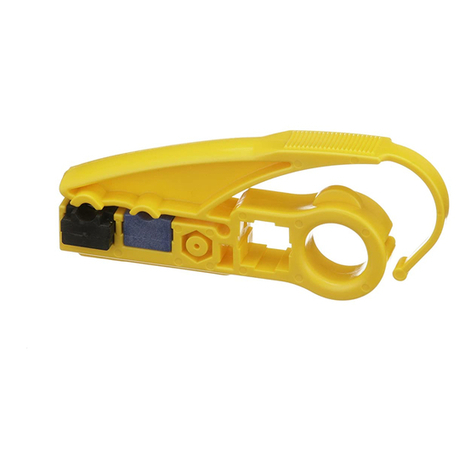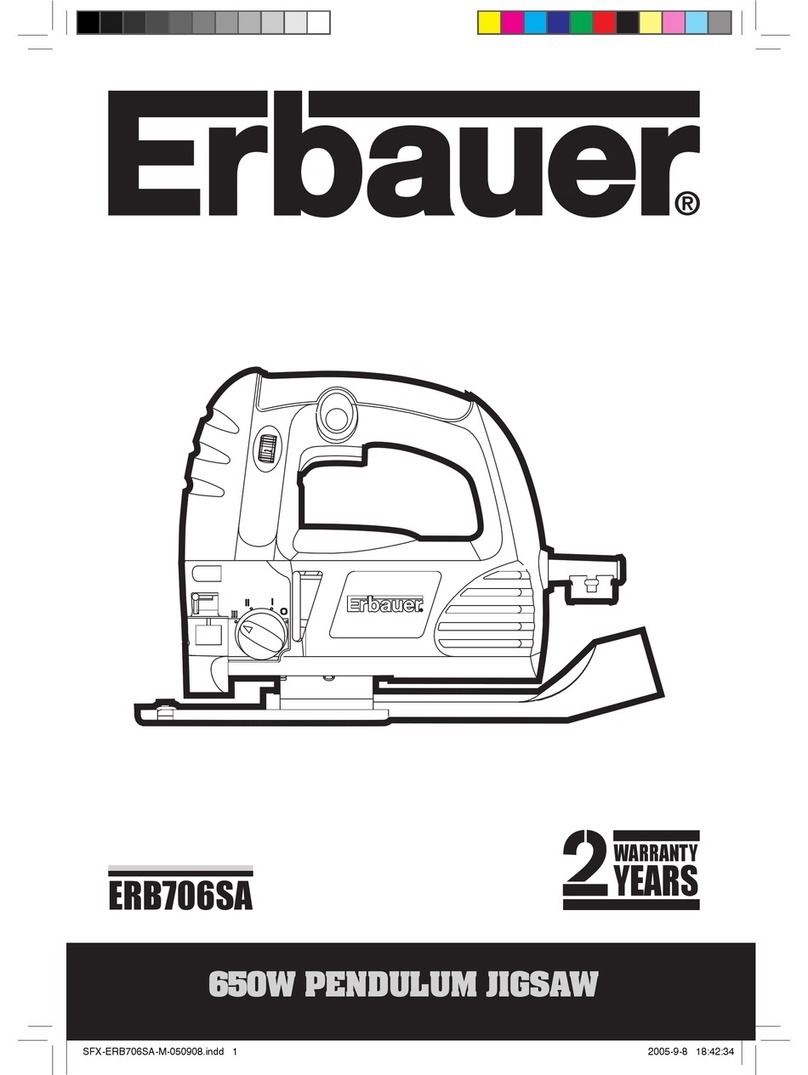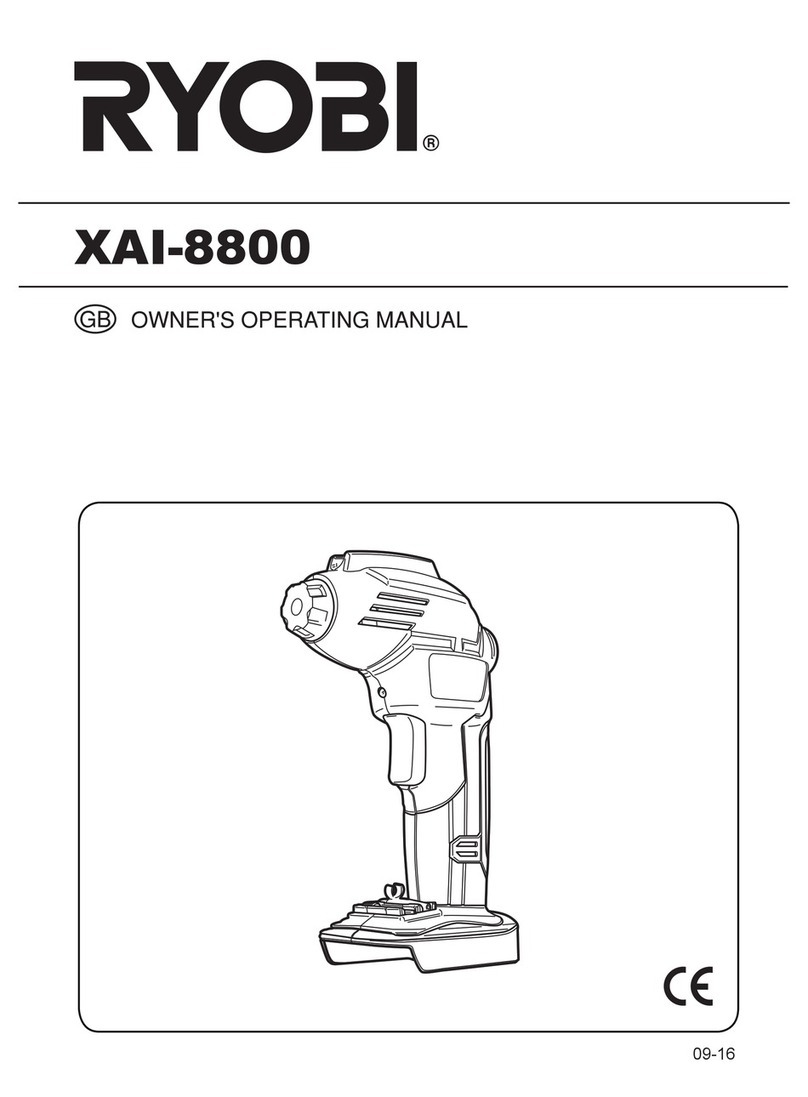ToolPRO CSJ18G.9 User manual

TOOLPRO
18V Cordless Jigsaw
Instruction Manual
Important - Please read these instructions fully before operating or maintaining your
jig saw
These instructions contain important information that will help you get the best from your
jig saw, ensuring it remains safe to operate.
If you need help or have damaged or missing parts, call the Customer Helpline on 1300 889 028
After Sales Support
CSJ18G.9
FREE CALL 1300 889 028
EMAIL:salesau@positecgroup.com

Customer Helpline 1300 889 028
2
Contents
Safety Information....................................................................................................3
In The Box.................................................................................................................9
Accessories ..............................................................................................................9
Operating Instructions............................................................................................10
Working hints for your Jig Saw............................................................................... 13
Maintenance ........................................................................................................... 17
Disposal of an exhausted battery pack ...................................................................17
Troubleshooting......................................................................................................17
Technical Data ........................................................................................................18

Customer Helpline 1300 889 028
3
Safety Information
Important - Please read these instructions fully before starting assembly
Warning Symbols
To reduce the risk of injury, Please read the instruction manual
Warning
Wear ear protection Wear eye protection
Wear dust mask Indoor use only
Do not expose to rain or water Do not burn
Waste electrical products must not be disposed of with household waste. Please recycle
where facilities exist. Check with your local authorities or retailer for recycling advice.
Li-ion battery. This product has been marked with a symbol relating to ‘separate
collection’ for all battery packs and battery pack. It will then be recycled or
dismantled in order to reduce the impact on the environment. Battery packs can be
hazardous for the environment and for human health since they contain hazardous
substances.
Fuse
Positive terminal
Negative terminal
Read the operator’s manual
Double insulation
RCM marking
ABN: Australian Business Number. By this number, business information such as entity
type, status, business location etc. can be found at website http://abr.business.gov.au.
ABN of Positec Australia Pty Limited is 14 101 682 357
Li-I on Li-Ion

Customer Helpline 1300 889 028
4
Safety Information
Important - Please read these instructions fully before starting assembly
General Power Tool Safety Warnings
WARNING! Read all safety warnings and all instructions. Failure to follow the
warnings and instructions may result in electric shock, fire and/or serious injury.
Save all warnings and instructions for future reference.
The term “power tool” in the warnings refers to your mains-operated (corded) power tool or
battery-operated (cordless) power tool.
1) Work area safety
a) Keep work area clean and well lit. Cluttered or dark areas invite accidents.
b) Do not operate power tools in explosive atmospheres, such as in the presence of
flammable liquids, gases or dust. Power tools create sparks which may ignite the dust
or fumes.
c) Keep children and bystanders away while operating a power tool. Distractions can
cause you to lose control.
2) Electrical safety
a) Power tool plugs must match the outlet. Never modify the plug in any way. Do not
use any adapter plugs with earthed (grounded) power tools. Unmodified plugs and
matching outlets will reduce risk of electric shock.
b) Avoid body contact with earthed or grounded surfaces, such as pipes, radiators,
ranges and refrigerators. There is an increased risk of electric shock if your body is
earthed or grounded.
c) Do not expose power tools to rain or wet conditions. Water entering a power tool will
increase the risk of electric shock.
d) Do not abuse the cord. Never use the cord for carrying, pulling or unplugging the
power tool. Keep cord away from heat, oil, sharp edges or moving parts. Damaged or
entangled cords increase the risk of electric shock.
e) When operating a power tool outdoors, use an extension cord suitable for outdoor use.
Use of a cord suitable for outdoor use reduces the risk of electric shock.
f) If operating a power tool in a damp location is unavoidable, use a residual current
device (RCD) protected supply. Use of an RCD reduces the risk of electric shock.
3) Personal safety
a) Stay alert, watch what you are doing and use common sense when operating a power
tool. Do not use a power tool while you are tired or under the influence of drugs,
alcohol or medication. A moment of inattention while operating power tools may result
in serious personal injury.
b) Use personal protective equipment. Always wear eye protection. Protective equipment
such as dust mask, non-skid safety shoes, hard hat, or hearing protection used for
appropriate conditions will reduce personal injuries.
c) Prevent unintentional starting. Ensure the switch is in the off-position before
connecting to power source and/or battery pack, picking up or carrying the tool.
Carrying power tools with your finger on the switch or energising power tools that have
the switch on invites accidents.
d) Remove any adjusting key or wrench before turning the power tool on. A wrench or a

Customer Helpline 1300 889 028
5
Safety Information
Important - Please read these instructions fully before starting assembly
General Power Tool Safety Warnings
key left attached to a rotating part of the power tool may result in personal injury.
e) Do not overreach. Keep proper footing and balance at all times. This enables better
control of the power tool in unexpected situations.
f) Dress properly. Do not wear loose clothing or jewellery. Keep your hair, clothing and
gloves away from moving parts. Loose clothes, jewellery or long hair can be caught in
moving parts.
g) If devices are provided for the connection of dust extraction and collection facilities,
ensure these are connected and properly used. Use of dust collection can reduce dust-
related hazards.
4) Power tool use and care
a) Do not force the power tool. Use the correct power tool for your application. The
correct power tool will do the job better and safer at the rate for which it was designed.
b) Do not use the power tool if the switch does not turn it on and off. Any power tool that
cannot be controlled with the switch is dangerous and must be repaired.
c) Disconnect the plug from the power source and/or the battery pack from the power
tool before making any adjustments, changing accessories, or storing power tools.
Such preventive safety measures reduce the risk of starting the power tool accidentally.
d) Store idle power tools out of the reach of children and do not allow persons unfamiliar
with the power tool or these instructions to operate the power tool. Power tools are
dangerous in the hands of untrained users.
e) Maintain power tools. Check for misalignment or binding of moving parts, breakage of
parts and any other condition that may affect the power tool’s operation. If damaged,
have the power tool repaired before use. Many accidents are caused by poorly
maintained power tools.
f) Keep cutting tools sharp and clean. Properly maintained cutting tools with sharp
cutting edges are less likely to bind and are easier to control.
g) Use the power tool, accessories and tool bits etc. in accordance with these
instructions, taking into account the working conditions and the work to be performed.
Use of the power tool for operations different from those intended could result in a
hazardous situation.
5) Battery tool use and care
a) Recharge only with the charger specified by the manufacturer. A charger that is
suitable for one type of battery pack may create a risk of fire when used with another
battery pack.
b) Use power tools only with specifically designated battery packs. Use of any other
battery packs may create a risk of injury and fire.
c) When battery pack is not in use, keep it away from other metal objects, like paper
clips, coins, keys, nails, screws or other small metal objects, that can make a
connection from one terminal to another. Shorting the battery terminals together may
cause burns or a fire.
d) Under abusive conditions, liquid may be ejected from the battery; avoid contact. If
contact accidentally occurs, flush with water. If liquid contacts eyes, additionally seek
medical help. Liquid ejected from the battery may cause irritation or burns.

Customer Helpline 1300 889 028
6
Safety Information
Important - Please read these instructions fully before starting assembly
General Power Tool Safety Warnings
6) Service
Have your power tool serviced by a qualified repair person using only identical
replacement parts. This will ensure that the safety of the power tool is maintained.
1. Always wear a dust mask.
2. Hold power tool by insulated gripping surfaces when performing an operation where
the cutting tool may contact hidden wiring. Cutting accessory contacting a ‘live” wire
may make exposed metal parts of the power tool “live” and could give the operator an
electric shock.
WARNING: Some dust particles created by power sawing, contain chemicals
known to cause cancer, birth defects or other reproductive harm. Some examples of
these chemicals are:
●Lead from lead-based paints.
●Crystalline silica from bricks and cement and other masonry products.
●Arsenic and chromium from chemically treated lumber.
Your risk from these exposures varies, depending upon how often you do this type of work.
To reduce your exposure to these chemicals:
●Work in a well-ventilated area.
●Work with approved safety equipment, such as those dust masks that are specially
designed to filter microscopic particles.
a) Do not dismantle, open or shred cells or battery pack.
b) Do not short-circuit a battery pack. Do not store battery packs haphazardly in a box or
drawer where they may short-circuit each other or be short-circuited by conductive
materials. When battery pack is not in use, keep it away from other metal objects, like
paper clips, coins, keys, nails, screws or other small metal objects, that can make a
connection from one terminal to another. Shorting the battery terminals together may
cause burns or a fire.
c) Do not expose battery pack to heat or fire. Avoid storage in direct sunlight.
d) Do not subject battery pack to mechanical shock.
e) In the event of battery leaking, do not allow the liquid to come into contact with the
skin or eyes. If contact has been made, wash the affected area with copious amounts
of water and seek medical advice.
f) Seek medical advice immediately if a cell or battery pack has been swallowed.
g) Keep battery pack clean and dry.
h) Wipe the battery pack terminals with a clean dry cloth if they become dirty.
i) Battery pack needs to be charged before use. Always refer to this instruction and use
the correct charging procedure.
j) Do not maintain battery pack on charge when not in use.
k) After extended periods of storage, it may be necessary to charge and discharge the
battery pack several times to obtain maximum performance.
l) Battery pack gives its best performance when it is operated at normal room
temperature (20 °C ± 5 °C).
Additional safety rules for your jig saw
Safety Warnings for battery pack

Customer Helpline 1300 889 028
7
Safety Information
Important - Please read these instructions fully before starting assembly
General Power Tool Safety Warnings
General Safety Warnings for Battery Charger
m) When disposing of battery packs, keep battery packs of different electrochemical
systems separate from each other.
n) Recharge only with the charger specified by manufacturer. Do not use any charger
other than that specifically provided for use with the equipment. A charger that is
suitable for one type of battery pack may create a risk of fire when used with another
battery pack.
o) Do not use any battery pack which is not designed for use with the equipment.
p) Keep battery pack out of the reach of children.
q) Retain the original product literature for future reference.
r) Remove the battery from the equipment when not in use.
s) Dispose of properly.
WARNING: Read all safety warnings and all instructions. Failure to follow the warnings
and instructions may result in electric shock, fire and/or serious injury.
Save all warnings and instructions for future reference.
- This appliance is not intended for use by persons (including children) with reduced
physical, sensory or mental capabilities, or lack of experience and knowledge, unless they
have been given supervision or instruction concerning use of the appliance by a person
responsible for their safety.
- Children should be supervised to ensure that they do not play with the appliance.
If the supply cord is damaged, it must be replaced by the manufacturer, its service agent or
similarly qualified persons in order to avoid a hazard.
Additional safety instructions for your Battery Charger
1. Before charging, read the instructions.
2. For charge Li-ion battery pack only.
3. If the supply cord is damaged, it must be replaced by the manufacturer, its service agent
or similarly qualified persons in order to avoid a hazard.
4. The battery terminal not connected to the chassis has to be connected first. The other
connection is to be made to the chassis, remote from the battery and fuel line. The
battery charger is then to be connected to the supply mains.
5. After charging, disconnect the battery charger from the supply mains. Then remove the
chassis connection and then the battery connection.
6. Do not charge a leaking battery.
7. Do not use chargers for works other than those for which they are designed.
8. Before charging, ensure your charger is matching the local AC supply.
9. The charging device must be protected from moisture.
10.Do not use the charging device in the open.
11.Do not short out the contacts of battery or charger.
12.Respect the polarity “+/-“ when charging.
13.Do not open the unit and keep out of the reach of children.
14.Do not charge the batteries of other manufactures or ill-suited models.
15.Ensure that the connection between the battery charger and battery is correctly
positioned and is not obstructed by foreign bodies.

Customer Helpline 1300 889 028
8
16.Keep battery charger’s slots are free of foreign objects and protect against dirt and
humidity. Store in a dry and frost-free place.
17.When charging batteries, ensure that the battery charger is in a well-ventilated area
and away from inflammable materials. Batteries can get hot during charging. Do not
overcharge any batteries. Ensure that batteries and chargers are not left unsupervised
during charging.
18.Do not recharge non-rechargeable batteries, as they can overheat and break.
19.Longer life and better performance can be obtained if the battery pack is charged when
the air temperature is between 18oC and 24oC. Do not charge the battery pack in air
temperatures below 4.5oC, or above 40.5oC. This is important as it can prevent serious
damage to the battery pack.
20.Charge only battery pack of the same model provided by manufacturer and of models
recommended by manufacturer.
Safety Information
Important - Please read these instructions fully before starting assembly
General Power Tool Safety Warnings

Customer Helpline 1300 889 028
9
In The Box
Parts
Pendulum Action Control
Roller Guide
Wood cutting blade
Tool-free Blade Holder
Finger Protection
Lock-off Button
On/Off switch
Hand Grip Areas
Allen key
Base Plate
Angle Plate
1
2
3 9
4
5
6
7
8
10
11
Accessories
Allen key 1pc
Wood cutting blade 1pc
11
9
10
5678
4
1 32

Customer Helpline 1300 889 028
10
Operating Instructions
NOTE: Before using the tool, read the instruction book carefully.
Intended Use
This tool is intended for sawing wood, plastic, metal and building materials while resting
firmly on the workpiece. It is suitable for straight and curved cuts with bevel angles to 45°.
The saw blade recommendations are to be observed.
1. CHARGING
We strongly recommend to use ToolPRO battery & charger kit. Please contact you local
Supercheap Auto store for more details or log onto www.supercheapauto.com.au for
Australia or www.supercheapauto.co.nz for New Zealand customers to find out more
details.
BEFORE PUTTING INTO OPERATION
CHARGING THE BATTERY PACK (SEE FIG. A)
NOTE:
a) The battery in your new tool is not charged when it leaves the plant. Therefore it must
be full charged before using the first time.
b) Do not use any charger other than that specifically provided for use with the equipment.
c) If the battery pack is very hot you must remove your battery pack from the charger and
allow time for the battery to cool down before recharging.
d) Please charge the battery to reach full or no less than half charge before storage. If the
tool will not be used for long periods of time, charge the battery every 3-6 months.
CHARGING PROCEDURE
1) Plug the charger into an appropriate outlet.
2) Place the battery pack into the charger
3) When charging is completed, unplug the charger and remove the battery pack.
Note: If the battery pack is locked in the charger, press the battery pack release button
and remove it.
WARNING: When battery charge runs out after continuous use or exposure to
direct sunlight or heat, allow time for the tool to cool down before re-charging to
achieve the full charge.

Customer Helpline 1300 889 028
11
Operating Instructions
CHARGING INDICATOR
1、Fast charger(See fig. A1)
Light ON/OFF flash Status
Red on Charging
Red flash - - - - - Defective Battery
Green on Fully Charged
Green flash - - - - - - Hot/Cold Delay
2、Slow charger(See fig. A2)
Light ON/OFF flash Status
Green flash - - - - - Charging
Green on Fully Charged
a
b
c
A1 A2
B C
D
E F

Customer Helpline 1300 889 028
12
Operating Instructions
4
B1 B2
C
1. INSTALLING AND REMOVING THE BATTERY PACK (not supplied)
A) TO REMOVE THE BATTERY PACK (SEE FIG B1)
Depress the Battery Pack Release Button firmly first and then slide the Battery Pack out
from your tool.
B) TO INSTALL THE BATTERY PACK (SEE FIG B2)
Slide the fully charged Battery Pack onto the tool with sufficient force until it clicks into
position.
2. HAND GRIP AREAS
Always ensure you maintain a firm grip whilst operating your jigsaw.
3. ALLEN KEY STORAGE
The allen key (4) is placed at the position as shown in FIG C.

Customer Helpline 1300 889 028
13
4. BLADE FITTING (SEE FIG. D, E, F)
NOTE: Before any work on the tool itself, remove the battery. Wear protective gloves when
assembling the saw blade. You can only use the blade type shown in (FIG D). Don’t use other
blade types.
INSERTING THE SAW BLADE
To open the Tool-free Blade Holder (10) rotate the ring clockwise (Jigsaw upside down)
and hold in position (SEE FIG D). Then fully insert the blade into the blade holder slot with
blade teeth facing forward and release the ring, which will self rotate and clamp over the
top of the blade. Push the blade into the blade holder again to ensure it is locked in position.
Ensure the edge of the blade is located in the groove of the blade guide (SEE FIG F).
REMOVING THE SAW BLADE
To remove a blade, hold the blade and rotate the blade holder ring clockwise then lift out
the blade (blade could be spring ejected).
WARNING: blade teeth are very sharp. For best cutting results ensure you use a blade
suited to the material and cut quality you need.
5. ROLLER GUIDE
Ensure the blade is located and runs smoothly in the groove (SEE FIG F) otherwise the
pendulum function will not work correctly and the blade will not be supported during cutting.
Operating Instructions
8
T-type Shank
10
D E
F

Customer Helpline 1300 889 028
14
Operating Instructions
6. ADJUSTING THE CUTTING ANGLE (SEE FIG. G, H)
Using a Allen key (4). Loosen the bolts securing the base plate (SEE FIG G). For preset
angles rotate so the lines of the angle on the base plate and angle plate (6) superposition
at the desired angle (0°, 15°, 30°, 45°) (SEE FIG H).For other miter angles, rotate to your
desired angle (use a protractor scale). Following one of the above procedures, hold the base
plate in position and firmly tighten the bolts to clamp the base plate at the desired angle.
Finally, check the angle and ensure the base plate is firmly clamped. The angle markings
on the base plate are accurate for most general purposes but it is recommended for
accurate work to set the angle with a protractor and make a test cut on other material.
7. STARTING OPERATION
1) LOCK OFF SWITCH
The lock off switch (2) is used to prevent unintentional starting. For starting operation of
the tool, first depress the lock-off button (1) and hold it in position, then press the lock off
switch and release the lever to start operation.
For safety reasons the lock off switch of the tool cannot be locked; it must remain pressed
during the entire operation.
2) FINGER PROTECTION
The finger protection is located in front of the blade holder. Whilst working, it will help
prevent accidental contact with moving blade.
4
G H

Customer Helpline 1300 889 028
15
Operating Instructions
8. PENDULUM ACTION CONTROL (SEE FIG I)
The pendulum action varies the forward cutting angle of the blade for increased cutting
efficiency. This can also be adjusted during no load running. Refer to the chart 1 for more
details. Do not use excessive blade force when cutting with the pendulum action. The blade
cuts on the upward stroke only.
Chart 1
0 Thin materials. Fine cuts. Tight curves.
I Hard materials, (e.g. steel & chipboard)
II Thick materials ( e.g. wood ) & plastic
III Fast cuts (e.g. softwood). Cutting in the direction of the wood grain.
7
I

Customer Helpline 1300 889 028
16
Working hints for your Jig Saw
If your jig saw becomes too hot, especially when used at low speed, set the speed to maximum
and run no Load for 2-3 minutes to cool the motor. Avoid prolonged usage at very low speeds.
GENERAL
Always use a blade suited to the material and material thickness to be cut. Always ensure
the work–piece is firmly held or clamped to prevent movement. For easier control, use low
speed to start cutting, then increase to correct speed.
Any movement of the material may affect the quality of the cut. The blade cuts on the
upward stroke and may chip the uppermost surface or face of the work piece. Ensure your
uppermost surface is a non-visible surface when your work is finished.
1. CUTTING LAMINATES
Use a fine tooth blade when cutting most laminates and thin wood materials. To reduce edge
chipping, clamp pieces of waste wood at both ends on both sides and cut through the waste
wood during cutting.
2. CIRCLE CUTTING
Do not use the pendulum action when cutting tight circles or angles.
3. PLUNGE SAWING
Plunge cutting may be used only on soft materials such as wood, aerated concrete, gypsum
plaster boards, etc.
Use only short saw blades.
Place the front edge of the base plate on the workpiece and switch on. Press the tool firmly
against the workpiece and plunge the saw blade slowly into the workpiece.
As soon as the complete surface of the base plate rests on the work piece, continue to saw
along the cutting line. (SEE FIG J, K)
4. METAL CUTTING
Use a finer tooth blade for ferrous metals and a coarse tooth blade for non-ferrous metals.
When cutting thin sheet metals, always clamp wood on both sides of the sheet to reduce
vibration or tearing of the sheet metal. Both wood and sheet metal must be cut. Do not force
the cutting blade when cutting thin metal or sheet steel, as they are harder materials and
will take longer to cut. Excessive blade force may reduce the life of the blade or damage the
motor. To reduce heat during metal cutting, add a little lubricant along the cutting line.
J K

Customer Helpline 1300 889 028
17
Before any work on the tool itself, remove the battery pack.
There are no user serviceable parts in your power tool. Never use water or chemical
cleaners to clean your power tool. Wipe clean with a dry cloth. Always store your power tool
in a dry place. Keep the motor ventilation slots clean. Keep all working controls free of dust.
Occasionally you may see sparks through the ventilation slots. This is normal and will not
damage your power tool.
Symptom: The tool suddenly stops during operation.
Possible Causes:
(1) Over load
(2) Battery temperature too high
(3) Low battery capacity
Possible Solution:
(1) Relieve the load on the machine immediately and allow cooling for approx. 30 seconds at
the highest no-load speed.
(2) Cool down a little while and use again, or change the battery pack.
(3) Charge the battery pack.
Maintenance
Disposal of an exhausted battery pack
Troubleshooting
To preserve natural resources, please recycle or dispose of the battery pack
properly. This battery pack contains Lithium batteries. Consult your local waste
authority for information regarding available recycling and/or disposal options.
Discharge your battery pack by operating your tool, then remove the battery pack
from the tool housing and cover the battery pack connections with heavy-duty adhesive
tape to prevent short circuit and energy discharge. Do not attempt to open or remove any of
the components.

Customer Helpline 1300 889 028
18
Technical Data
Voltage 18V
No load speed 0-2400/min
Stroke length 19mm
Cutting capacity Wood 65mm
Steel 5mm
Bevel capacity ±45°
Machine weight 1.82kg (Including battery)
Charging time 1-1.5hr by fast charger,
3-5hrs by slow charger
Charger Input 100-240V~50/60Hz
Charger Output 10.8~20V 1.5A by fast charger
10.8--20V 400mA by slow charger
Battery capacity 1.5/2.0Ah Li-ion battery
Technical Data Table
Staple your purchase receipt here
Before returning this product for
warranty or any other reason, please call.
POSITEC AUSTRALIA PTY LIMITED
ABN 14 101 682 357
Unit 15, 23 Narabang Way Belrose 2085 NSW Australia
FREE CALL 1300 889 028
EMAIL:salesau@positecgroup.com


Table of contents
Other ToolPRO Power Tools manuals
Popular Power Tools manuals by other brands
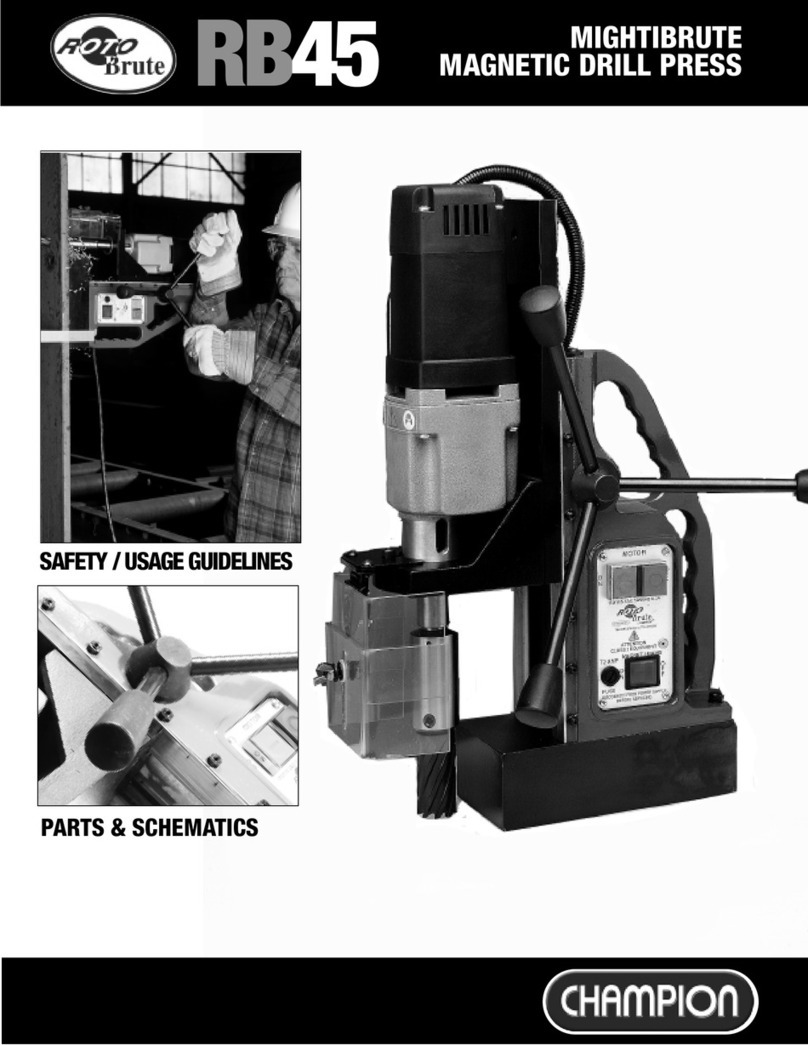
Champion
Champion Roto Brute RB45 Operating and safety instructions
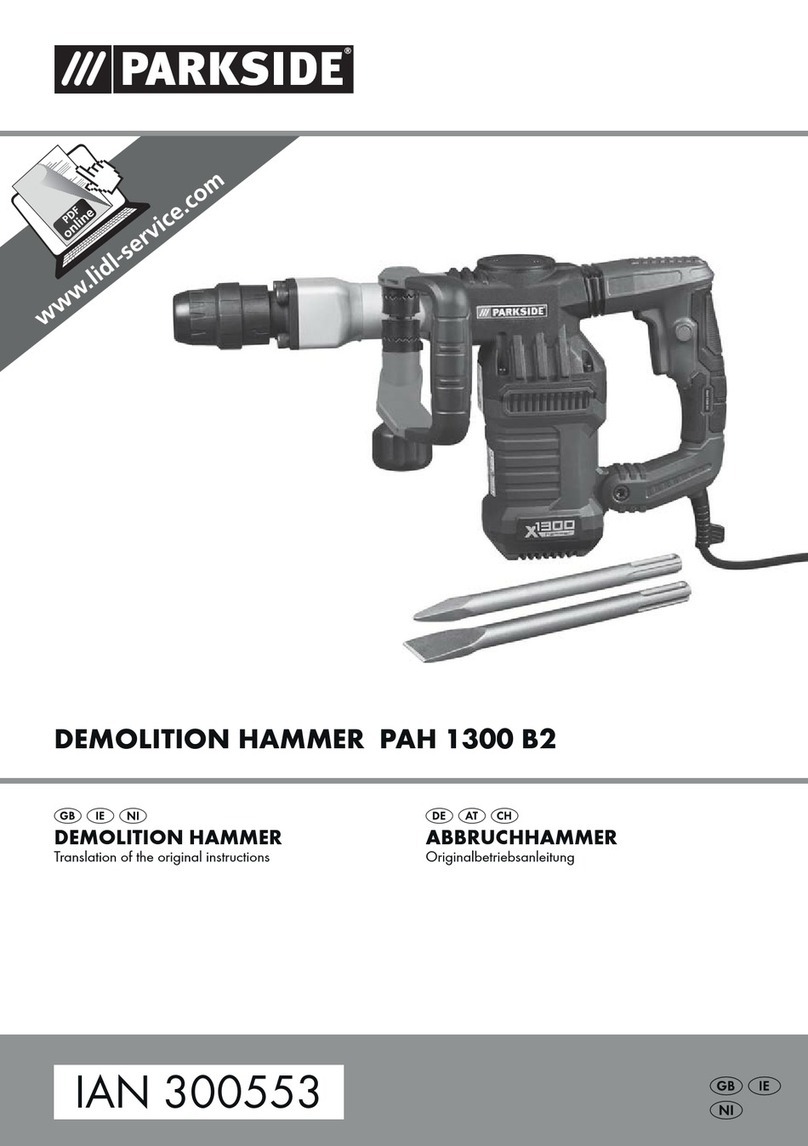
Parkside
Parkside PAH 1300 B2 Translation of the original instructions
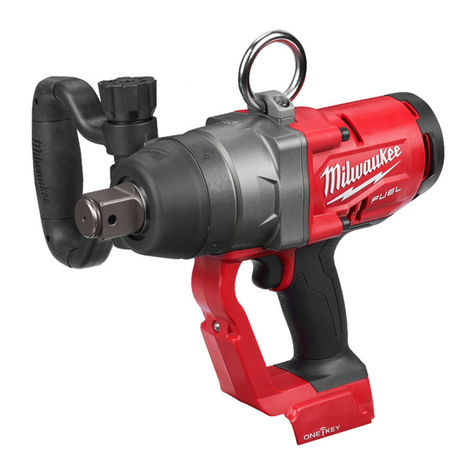
Milwaukee
Milwaukee M18 ONEFHIWF1 Original instructions

jbc
jbc MD 2960 instruction manual
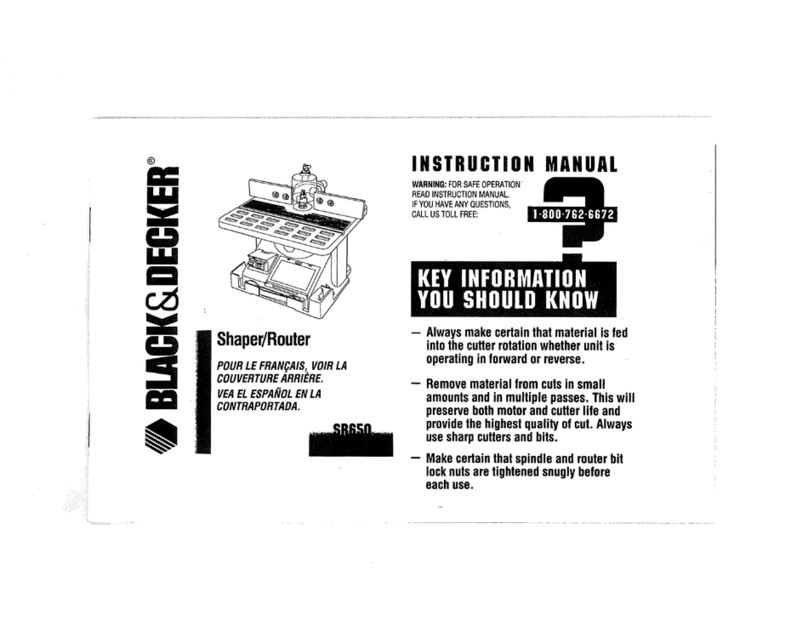
Black & Decker
Black & Decker SR650 instruction manual

Matco Tools
Matco Tools DT8 quick start guide
